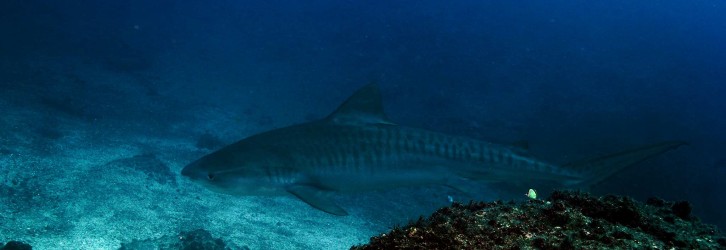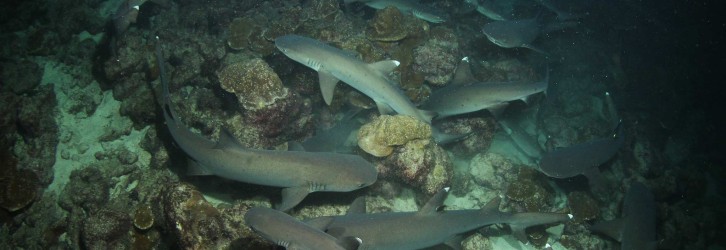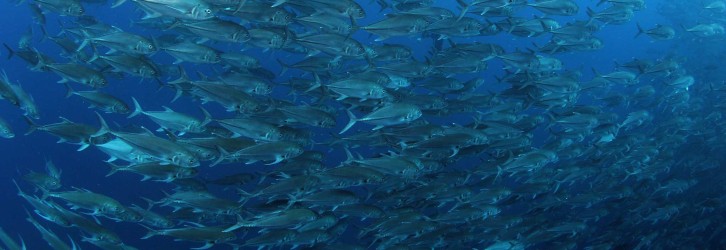Scuba Diving in Cocos
An isolated and protected haven for numerous shark species and prime destination for adventurous divers; Cocos Islands promises to test all your diving skills!
“Pura Vida” (pure life) is a popular catchphrase and lifestyle choice for many Costa Ricans; symbolising their passion for an eco-friendly and “pure” way of life in synergetic connection with the country’s vast expanses of rainforest and natural beauty. The allure of this natural (in some cases wild) destination attracts travellers seeking adventure, and for divers, this takes the form of the isolated world heritage site: Cocos Island.
About Cocos Island
Cocos is a serious adventurer’s destination! A rugged, jungle covered, uninhabited island (except for a permanent ranger station), and supposed treasure trove for 17th century pirates and now a nationally protected haven for elusive hammerhead sharks, skulking tiger sharks, countless white-tips, majestic whales and dolphins, and other large pelagic fish.
Location
Located almost 500 kilometres South West of the Costa Rican coast, Cocos island covers almost 24 square kilometres and is comprised of the main island and the largest islet: ‘Manuelita’.
Arriving and moving around
Reaching Costa Rica does not present a problem for most international carriers, yet of the country’s two International airports, the largest (and most convenient) is located on the outskirts of the capital of San Jose (with a departure tax of US$26). It is considerably distant from the coastline 2 hours away by shuttle. Fortunately the capital serves as the country’s transportation hub for private-shuttle and public buses to Punatarenas; one of the country’s main ports and base of operations for diving operators & liveaboards, that offer the only practical transportation to visit Cocos island 30-32 hours offshore. Visitors are warned: ocean conditions can be quite rough, and leave many travellers sea-sick during the traverse!
Climate & best time to visit
Given its location between the two tropics, cloudiness and rain are an annual occurrence, but tend to last only a few hours and make way to deep blue skies and sunshine. Consequently, the island benefits from a consistent tropical climate, with average annual temperatures of 26°c (on land & underwater) and an abundance of lush jungle and waterfalls. Cocos does witness “drier” periods from January to March and to a lesser extent September to October, although diving conditions can be considered peak year round.
Currency and prices
The local currency is the Costa Rican Colon (CRC) and € 1 equals c.a. 755 CRC, making this a relatively affordable destination. Unless travellers intend to visit other parts of Costa Rica, there is no necessity to exchange into Colon since most diving operators & liveaboards to Cocos prefer advance payment prior to arrival. Also most hotels and resorts accept dollars and major credit cards.
Where to dive
The deep waters surrounding Cocos are admired by many scuba divers for their abundance of large pelagic species; indeed it is not uncommon to encounter dozens if not hundreds of Scalloped Hammerhead-sharks (Sphyrna lewini) during every dive. Currents and visibility at Cocos are not much different from other global dive destinations, however its location in the open ocean can present a challenge to lesser experienced divers. Average dive depths can range from 18-40m and so being at least a PADI Advanced Open Water & Nitrox Certified diver (or the equivalent) is recommended. Of course a knowledgeable dive guide will determine the best daily-dive-sites, but here are some sites you may wish to make a note of visiting:
Manuelita Islet
The largest of the islets surrounding Cocos offers 2 distinct dive-sites; a coral garden on the Eastern “interior” (Manuelita Somero) and a gradual decent on the Western “exterior” facing the Pacific Ocean (Manuelita Profundo). Depths range from 6-21m and 18-39m respectively, boasting the largest range of both macro & micro marine life on location. Divers can enjoy countless reef fish, lobsters, and White-tip Reef Sharks (Triaenodon obesus). Larger animals to be seen include Marble Rays (Taeniura meyeni), Eagle Rays (Aetobatus narinari), Green Sea Turtles (Chelonia mydas), Mobulas (Mobula mobular) and until only recently Tiger Sharks (Galeocerdo cuvier). Manuelita Somero is also a favourite site for night-dives, when white-tips numbers seem endless as they carpet the sea floor hunting for prey in the torch-light!
Dirty Rock
Home to a diversity of sea-birds which cover this small island in “debris” is how the site got this peculiar name; and yet, despite this unpleasant fact, Dirty Rock is among the island’s most popular locations. Dropping to 35m from the surface, the dynamic rock formations below are covered with cleaner fish such as Passer Angelfish (Holacanthus passer) which attract an abundance of larger animals. Darting in and around this underwater labyrinth divers can expect to see Galapagos Sharks (Carcharhinus galapagensis), Marble Rays (Taeniura meyeni), White-Tip Reef Sharks (Triaenodon obesus), Scalloped Hammerheads (Sphyrna lewini), and Big-Eye Trevally (Caranx sexfasciatus) forming impressive whirlwind-schools in their thousands! During the months of January to March, if divers are fortunate enough, this site hosts up to a dozen Whale Sharks (Rhincodon typus) as they migrate through this haven.
Submerged Rock
With striking scenery and numerous schools of fish, this impressive underwater archway presents fantastic photo-opportunities from depths ranging 6-33m. Some of the marine life is accustomed to the presence of divers and occasionally curious towards them; indeed Marble Rays (Taeniura meyeni) can occasionally swim over the bubbles of divers to rid themselves of parasites. Swimming through the archway is also an exhilarating experience and unique photo-opportunity; with curtains of hundreds of Burito Grunts (Anisotremus interrupts) and Blue-lined Snappers (Lutjanus quinquelineatus) opening to make way for divers or White-tip reef sharks (Triaenodon obesus) which come to rest under the archway and even give birth a this site.
Bajo Alcyone
This seamount is among the more challenging dives on location, but also one of the most rewarding! Its distance from Cocos can often mean having to brave rough sea conditions, and most of the action takes place at depths ranging from 27-36m. Once underwater, divers can expect to be approached and in some cases followed by Mexican Hogfish (Bodianus diplotaenia) hoping to catch any morsels stirred up by a diver’s fins. Schools of fish such as Almaco Jacks (Seriola rivoliana) and Big-Eye Trevally (Caranx sexfasciatus) are not only incredibly large at this site, but a lot more common than other sites in Cocos. Divers who are fortunate enough can witness these schools being corralled by larger pelagics including Bottle Nose Dolphins (Tursiops truncatus), Silky Sharks (Carcharhinus falciformis), and Galapagos Sharks (Carcharhinus galapagensis). However, what truly rewards divers who visit this site are the “ceilings” of Scalloped Hammerhead Sharks (Sphyrna lewini) which can be in their hundreds! A truly unforgettable experience!
What else to do?
Of course the remoteness of Cocos can limit the variety of alternatives to diving, but there are other activities which visitors can enjoy. Kayaking and snorkelling is possible from most liveaboards. With ample notice and permission from the island’s Costa Rican Park Rangers, visitors are welcome to enjoy Cocos’ natural beauty on guided hikes. These educate visitors about endemic species of flora and fauna and about the importance of conserving both the island and its waters. Indeed one of the island’s attractions is the “Genius Bridge” – constructed entirely with materials confiscated from poachers. All part of a larger scale effort to protect the “Golden Triangle” – a triad of islands including Cocos, Malpelo, and Galapagos.
Cocos scuba articles
Articles about diving points and sea life in Cocos

The Hammerhead Triangle – Cocos, Galapagos and Malpelo
Cocos underwater photos
Underwater photos taken in Cocos






